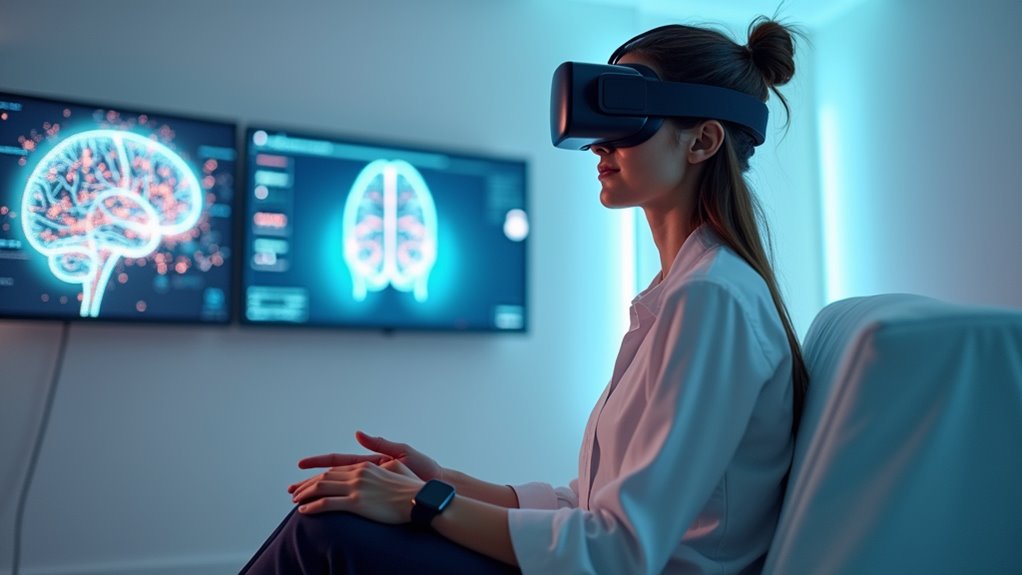You’ll find the most effective addiction treatment programs in 2025 combine evidence-based medical interventions with technology-enhanced monitoring and personalized recovery plans. Modern programs integrate medication-assisted treatment (MAT), mindfulness practices, and virtual reality therapy while using AI-driven data analysis to predict relapse risks. Trauma-informed care and holistic approaches have shown 65% better outcomes when paired with traditional treatments. Understanding these cutting-edge treatment options can transform your path to recovery.
Evidence-Based Treatment Models Leading Recovery Success

As addiction treatment evolves in the direction of evidence-based approaches, emerging research confirms the effectiveness of multiple therapeutic modalities working in concert.
You’ll find that combining Medication for Addiction Treatment (MAT) with mindfulness-based interventions produces measurable recovery metrics, particularly for opioid and alcohol use disorders.
Federal funding support has significantly expanded access to comprehensive treatment programs nationwide.
Evidence-based practices now emphasize personalized treatment paths that incorporate both pharmacological and behavioral interventions.
You can access cutting-edge treatments like GLP1 drugs for alcohol use disorder, while naltrexone offers flexible options for moderation-based recovery goals.
The integration of mindfulness techniques with traditional therapies improves emotional regulation and reduces relapse risks.
This extensive approach, supported by clinical studies, demonstrates superior outcomes compared to single-modality treatments, especially when customized to your specific recovery needs and cultural background.
virtual care solutions has dramatically improved access to treatment for individuals in rural and underserved areas.
Digital tools like fitness tracking apps are increasingly integrated into treatment programs to enhance patient accountability and progress monitoring.
Technology-Enhanced Rehabilitation Programs and Outcomes

While traditional rehabilitation approaches remain foundational, technology-enhanced treatment programs now form the backbone of modern addiction recovery. Collaborative care teams ensure comprehensive treatment through coordinated provider communication. Digital tools create online communities that provide constant peer support and accountability throughout recovery.
You’ll find AI Tools analyzing real-time patient data to predict relapse risks and customize treatment plans, while Virtual Reality environments provide safe spaces to practice coping strategies. Advanced biosensors like PneumoWave ALERT monitor vital signs to detect potential opioid-related emergencies.
Telehealth Solutions extend care to remote populations through hybrid models combining digital and in-person support.
Wearable Technology monitors physiological markers, enabling immediate interventions when needed, and Data Analytics drives evidence-based decision-making for treatment optimization.
- Experience immersive VR therapy sessions that help you confront triggers without real-world risks
- Access 24/7 support through AI-powered platforms that understand your unique recovery path
- Connect with therapists instantly through secure telehealth platforms during critical moments
- Track your progress with wearable devices that alert your care team before relapse occurs
Personalized Medical Interventions: A Game-Changing Approach

Through groundbreaking advances in genetic profiling and neurobiological understanding, personalized medical interventions have revolutionized addiction treatment outcomes. Early disease prevention through genomic screening helps identify addiction vulnerabilities before dependence develops.
You’ll now receive targeted medications based on your unique genetic markers, greatly reducing adverse reactions while maximizing therapeutic benefits. This precision approach pairs customized pharmacological treatments with behavioral therapies for ideal results. Regular evaluations monitor treatment effectiveness and allow for timely adjustments to your care plan.
For those with dual diagnosis conditions, you’ll experience integrated treatment protocols that simultaneously address both substance use and mental health disorders. With licensed therapists available, specialized mental health support ensures comprehensive care throughout your recovery journey.
Your care team will utilize advanced biomarker testing to create a customized medication schedule, often incorporating creative treatments like GLP-1 receptor agonists and transcranial stimulation.
You’ll actively participate in developing your treatment strategy, ensuring the plan aligns with your specific needs and preferences while maximizing your chances for sustainable recovery.
The Rise of Holistic Treatment Integration
Modern holistic treatment approaches have transformed addiction recovery by integrating evidence-based alternative therapies with traditional medical interventions.
You’ll find extensive programs now combining mindfulness practices, trauma-informed care, and technology-driven solutions to address both physical and psychological aspects of addiction. The comprehensive focus on mind-body wellness has become central to successful treatment programs. Treatment centers report that integrated treatment approaches improve recovery outcomes by over 65%. Art therapy has emerged as a powerful tool, with 36.8% of programs now offering creative expression activities.
- Experience the power of Mindfulness-Based Cognitive Therapy, which cuts relapse rates by 50% while helping you process underlying emotional challenges
- Gain control through personalized digital monitoring that tracks your progress and adjusts treatment in real-time
- Access virtual reality therapy sessions that help you practice coping skills in safe, controlled environments
- Connect with peer support networks that understand your path, strengthening your recovery through shared experiences
These integrated approaches reflect the latest understanding that successful recovery requires addressing the whole person, not just the addiction.
Extended Support Networks: The Key to Long-Term Recovery
Successful long-term recovery extends far beyond initial treatment, requiring strong support networks that span multiple dimensions of care.
You’ll find that peer mentoring through organizations like AA provides essential ongoing support, while technology-enabled solutions offer 24/7 access to crisis intervention and progress tracking. These support networks create vital accountability partnerships that foster enduring sobriety.
Family dynamics play a pivotal role in sustaining recovery, as educated and engaged family members help create supportive environments and strengthen communication. Trauma-sensitive care has become fundamental to modern recovery programs, ensuring emotional safety and trust-building among participants.
You can access extensive support through community integration programs that combine sober living arrangements, workforce development, and centralized recovery services.
Modern treatment approaches now incorporate VR therapy and wearable biosensors to improve relapse prevention, while expanded Medicaid coverage and increased federal funding guarantee these services remain accessible.
This multi-layered support system greatly enhances your chances of maintaining long-term sobriety.
Frequently Asked Questions
How Much Do Insurance Companies Typically Cover for Addiction Treatment Programs?
Your insurance coverage for addiction treatment typically ranges from 60-100% of costs, depending on your plan and provider network.
You’ll find that in-network services usually receive better coverage, with insurers commonly covering medical detox, residential rehab (30-90 days), and outpatient therapy.
You’ll need to take into account deductibles, copayments, and prior authorization requirements.
Treatment costs can vary greatly, but insurance often provides substantial financial support when you use approved providers.
What Percentage of Patients Successfully Maintain Sobriety After Completing These Programs?
Your chances of maintaining sobriety vary based on several factors, but recent success rates are encouraging.
Data shows you’ll have a 70-76% likelihood of remaining sober during the critical 3-9 month period after alcohol treatment.
You’ll greatly improve your sobriety statistics by participating in thorough aftercare programs.
While long-term success rates fluctuate, you’ll maintain better outcomes through continued support, medication-assisted treatment, and regular therapy sessions.
Can Family Members Participate in Virtual Therapy Sessions During Residential Treatment?
Yes, you can involve your family in virtual therapy sessions during residential treatment.
Modern treatment centers offer virtual family counseling and educational webinars that allow your loved ones to participate remotely.
Family involvement through digital platforms provides essential support while you’re in treatment, and research shows it strengthens recovery outcomes.
You’ll benefit from improved family communication, understanding of addiction dynamics, and a more resilient support system during your recovery path.
Are There Age Restrictions for Different Types of Addiction Treatment Programs?
You’ll find that maturity restrictions vary across treatment programs, with most services offering maturity-specific programs to address unique needs.
While adult programs typically accept clients 18+, youth interventions often require parental consent and serve teens 13-16+.
For medication-assisted treatment (MAT), you’ll generally need to be 18+, though exceptions exist for severe cases.
Elderly clients can access most programs, with protocols adjusted for maturity-related health considerations and medication metabolism.
How Long Is the Average Waiting Period to Enter High-Demand Treatment Facilities?
You’ll typically encounter varying waiting times for high-demand treatment facilities, ranging from 2-8 weeks.
Treatment accessibility depends on several factors: facility type, location, and program specifics.
You’ll find longer waits (8+ weeks) for facilities offering integrated care and medical detox, while shorter waits (2-4 weeks) are common for outpatient programs.
If you’re seeking publicly funded treatment, you might face extended waiting periods due to limited resources and high demand.






